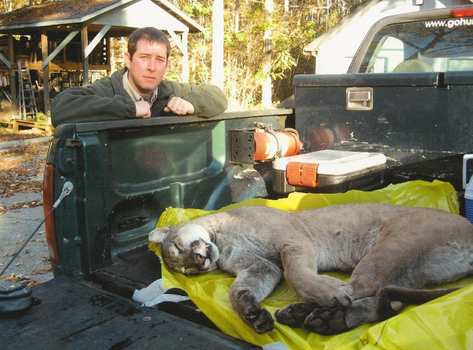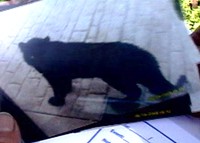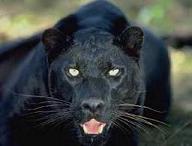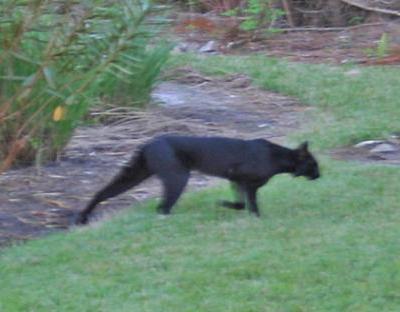What Is A Panther?
Posted by: Loren Coleman on December 3rd, 2008

The Georgia Panther’s body is displayed above.
An Australian reader writes in, asking:
“Panther? I find the terminology all too confusing. Isn’t this cat [pictured above] killed a puma? Isn’t a panther always black, and either a jaguar or leopard?”
So, for this sincerely confused resident of Oz, what is the meaning of the term “panther” and what animals can be called a “panther”?
Well, technically, there are many meanings for “panther.” Using the source school children click to first, let’s see what Wikipedia says, as applied to the felids:
Large Cats
Panthera, the feline genus which contains lions, tigers, leopards and jaguars
Panther (in Africa and Asia), the leopard (Panthera pardus)
Panther (in North America), the cougar or mountain lion (Puma concolor)
Florida panther, a subspecies of cougar (Puma concolor coryi or Puma concolor couguar) found in southern Florida
Panther (in South and Central America), the jaguar (Panthera onca)
Black panther, a black variant of leopard, cougar or jaguar
White panther, a white or very pale variant of leopard, cougar or jaguar
Panther (legendary creature), a mythical creature resembling a large multicolored cat
Wikipedia didn’t seem to have a reference to “Phantom Panthers,” but if you’re reading this, you probably are already familiar with that term for cryptid large mystery felines.

A Newton County, Missouri, sheriff’s deputy shot and killed a large, black, declawed cat (above, alive, the so-called “Neosho panther”), which turned up in a residential yard on May 19, 2008. Steve Bircher, curator of mammals/carnivores at the St. Louis Zoological Park, positively identified the dead felid as a leopard (Panthera pardus), although some questioned that non-DNA identification.
No known, recognized, or verified forms of black or melanistic pumas, cougars, mountain lion, or whatever you want to call them are known from North America. Needless to say, a find of a dead black puma, i.e. mountain lion, or a classic black panther, i.e. melanistic leopard (that is not a former captive) verified as being a native of North America would be a remarkable cryptozoological discovery.
Black ~ melanistic ~ jaguars are not native to most of the United States, although they are reported sporadically from the American Southwest. There are no confirmed feral populations of escaped melanistic leopards in North, Latin, or South America, of this Old World species.
Some of these mystery cats reported are merely the eastern subspecies of the mountain lion or puma, Puma concolor couguar, repopulating its old niches. But perhaps most importantly, the puma is tawny in color, not black.
One of the most frequently reported cryptids, the mystery cats of North America, are, more often than not, described as “black panthers.” Generally, one thinks of the melanistic leopard of Africa and Asia as the black panther, but it is the puma of the New World that is the skeptic’s usual flesh and blood rebuttal to these accounts of large, black cats.
To confuse matters even further, “panther” is a term synonymous with mountain lion, puma, catamount, cougar, or painter; all supposedly denote, at least in North America, the same animal, a tawny (not a black) felid.
To continue this discussion, I share the following passage from my Mysterious America:
The record of a black puma displaying the melanistic color phase is so rare that the one or two cases seemingly accepted are in dispute. In 1843, an alledgedly melanistic puma supposedly was killed in the Carandehy River section of Brazil. There is no record of what became of the body. Perhaps it was a black jaguar, after all.
“Black pumas” have attained almost folkloric status. The most significant proof appears to be that noted by J. B. Tinsley in The Puma: Legendary Lion of the Americas (1987), who published a photo of a black feline labeled: “Black puma, or pantera negra, killed by Miguel Ruiz Herrero in 1959 in the Province of Guanacaste along the north Pacific coast of Costa Rica.”
Still, these instances remain in question.
No scientifically verified melanistic Puma concolor of any subspecies is accepted.
Zoology texts indicate melanism in the Felidae, the family of cats, apparently runs the highest in the moist tropics and subtropics. The most frequent numbers of black mutations appear to occur in the jaguar (Panthera onca) of Latin and South America, and the leopard (Panthera pardus) of Asia, and less so of Africa.

The black jaguar found in Central and South America is comparatively rare. During the 1980s, when I conducted a global survey of captive melanistic felid holdings, not more than thirty jaguars populated the world’s zoological gardens. Of these, a large percentage found in zoos today continue to be related zoo-bred animals. Black jaguars, therefore, are not that common in the wild, and seem frequently to be concentrated in specific areas such as the jungle of Guyana Massif. As far as I have been able to determine and as Gerry Parker notes in his eastern panther book, no black jaguars have ever been captured or killed in the United States, although the spotted variety infrequently has been known to range into some parts of the Southwest. The black jaguar is a stocky beast, and quite different from the descriptions of our melanistc phantom felines, or so-called “black panthers.”

The black leopards of Africa and Asia are referred to as black panthers, and therein lies a good deal of confusion among people seeing the “panthers” of America. Within any litter of spotted leopards, the chances are high that one of the kits will be black. Among leopards of Asia, especially, the frequency of births and survival of black offspring is common.
Among African leopards, the black ones are rarer. It’s notable that these tend to come from the mountains of Kenya, the site of other anomalistic and melanistic felid sightings, especially the cryptid spotted and black lion reports, as well as those of accepted black specimens, such as the black serval.
Some laymen have wrongly viewed the black leopard as a separate species and labeled them “black panthers.” Since most people sense that a majority of the mystery cats are reported to be black, the phantom felines are thus tagged “black panthers” by the press and the witnesses. Because of such semantic games, the Illinois Department of Conservation, for example, can make ridiculous statements like the following:
“Now and then, rural communities in Illinois have a panther scare that reduces normal, thinking individuals into children that are afraid to step out in the dark. Usually, the alleged animal is said to be a black panther, not a cougar (puma). Cougars are not black, and black panthers are not native to the Western Hemisphere. In Africa and Asia where panthers do roam, the black panther is a rare animal because it is a freak, a melanist.”
[Mysterious America, ©Loren Coleman 1983, 1989, 2001, 2007.]
Of course, sometimes animals can be called a “panther,” incorrectly, usually just because they are literally a “phantom panther” or a black cat, including…

A black or melanitic serval, here photographed in the wild in Africa, and

A black bobcat, pictured from Florida.
Not to confuse the issue more, but it should be pointed out that in Australia, the reports of the “Blue Mountains Panther” have circulated for decades. Cryptomundo dealt with the latest news of these “panthers” (decidedly the melanistic variety of mystery cats) in September 2008, here. Residents of the Blue Mountains area, west of Sydney, New South Wales, Australia, have had encounters with these big black cats for at least a century. The theories for their origins are speculative and numerous, but it seems many of them focus on, well, I’ll just say it, Americans.
©
About Loren Coleman
Loren Coleman is one of the world’s leading cryptozoologists, some say “the” leading living cryptozoologist. Certainly, he is acknowledged as the current living American researcher and writer who has most popularized cryptozoology in the late 20th and early 21st centuries.
Starting his fieldwork and investigations in 1960, after traveling and trekking extensively in pursuit of cryptozoological mysteries, Coleman began writing to share his experiences in 1969. An honorary member of Ivan T. Sanderson’s Society for the Investigation of the Unexplained in the 1970s, Coleman has been bestowed with similar honorary memberships of the North Idaho College Cryptozoology Club in 1983, and in subsequent years, that of the British Columbia Scientific Cryptozoology Club, CryptoSafari International, and other international organizations. He was also a Life Member and Benefactor of the International Society of Cryptozoology (now-defunct).
Loren Coleman’s daily blog, as a member of the Cryptomundo Team, served as an ongoing avenue of communication for the ever-growing body of cryptozoo news from 2005 through 2013. He returned as an infrequent contributor beginning Halloween week of 2015.
Coleman is the founder in 2003, and current director of the International Cryptozoology Museum in Portland, Maine.










Interesting article. It illuminates the disparity between common usage names and the long history of naming animal species and the relatively recent historical system for scientific identification. The interest I have in things cryptic bleeds over into etymology, and so I’m looking forward to finding out more about this naming conundrum.
The thing that intrigues me, is how on earth did the puma come to be thought of as a “black panther”? It’s not a recent phenomenon, and it’s widely ingrained, at least here in the southeastern and midwestern USA. Ask almost anyone, and they will have some family anecdote of a relative or great-relative’s encounter with a “black panther”. And here, where nearly everyone lives “up a holler” (for those of you who aren’t familiar with Appalachian terminology, “up a holler” means “alongside a winding stream in a valley between steep mountaiins”)(“up a holler” is a lot quicker off the tongue 🙂 ) – anyhow, at the head of every holler, back in the hills, is at least one panther, jet black and usually huge.
I’ve tried to determine just when the term “black panther” became commonly used in the US, but I haven’t found anything yet that satisfies my curiousity. Surely though, it must have been at least 100 years ago, or more, because my grandmother thinks of panthers as invariably black, and so do all the old people. She has never seen one, but her father fought one with an axe when it jumped at her older sister in the woods, probably a hundred years ago. She does not remember him saying that it was black, she just assumes it was because “panthers are black”.
Kittenz,
Having grown up “up a holler” in eastern Kentucky, I understand exactly what you are saying. I grew up with those stories too. My dad told me a story of having a panther come down off the hill and stare at him through the screen of the kid’s bedroom window at his grandma’s house when he was young. He knew it was a big cat because of the distance of the window from the ground, and the way he described it, it was on its back feet, propped up with its front paws on the window pane, to look in. His panther, though, was the tawny colored variety. However we knew plenty of individuals who claimed to see “black panthers”. I just accepted them as one of those critters like foxes and bobcats that were there, but not often seen. As I grew up I wondered if maybe some of those “black panthers” weren’t just dark, but still tawny colored ones seen at night or in the shadows and misidentified as black. I’m still not sure what the answer is.
As far as more southern black cats, its interesting that the “black cougars” that Loren notes above were all killed in Latin American areas where they share a range with jaguars, something I’m sure critics would latch on to.
Personally, with the number of camera trap photos of jaguars coming out of the southwest, suggesting that the southwest isn’t just the “fringe” of territory they roam into occasionally , but part of their regular stomping grounds, I’m convinced that some of the more southern black panther reports might be the result of melanistic jaguars. In fact, I’ve often wondered if perhaps the image of the “black panther” entered the popular American conscious at a time when the jaguar range might have been larger and taxonomist a little more cavalier (ah, the wonders of modern DNA testing!). If this were the case then it would be easy for the startled holler dweller, raised on stories of black panthers, to see a “black” cat in the shadows when in fact it was really a more mundane (but no less scary to the witness) tawny puma.
Chester Moore has posited that southern black cat sighting are based on jaguarundi at the extreme limits of their range. While this may be true in some cases, the jaguarundi, with its sleek build and small head, just doesn’t fit the profile of the typical North American “black panther” in my opinion. However black jaguars, presently or historically, do fit the bill.
Of course, I’m looking at this more from a folkloric p.o.v. because of my background as a social sciences geek. From my perspective witnesses truly believe they have seen these creatures. If the creatures they claim to have seen truly are “impossible” I want to know a) what it was they did see and b) why they interpreted it in the way they did. That said, I will not be a bit surprised when an OOP black jaguar is killed in Mississippi, or the ever elusive melanistic cougar is finally produced.
Either tradition is causing hundreds of folks to incorrectly attribute a color phase to a critter that is real but that wildlife officials don’t want to acknowledge lives in that area, or we are dealing with an OOP cat that does express melanism, or people with no knowledge of wildlife are mistakenly identifying mundane animals and confabulating their size and color, or they are making it up. Personally, I lean more toward the first two explanations for the majority of solid reports that can’t be explained away, and for the latter two, I’ve found that the vigilant cryptid community usually clears it up before it gets too far out of hand (although their are exceptions).
But this many dead cat bodies… well, this is going to get kind of hard for wildlife officials to ignore if they keep turning up.
Maybe there was some cross breeding between cougars and jaguars and the melanistic trait was carried on by this hybrid.
I believe that most of the true “panther sightings”, in which someone really saw a long-tailed big cat in the USA, are just that: a tawny puma, seen against tha light, made darker by the imagination and by the common phrase “black panther”.
There are native legends of wild hybrids of jaguar & puma, in South America and parts of Mexico, but as far as I know, none have been confirmed. There has, however, been hybridization in captivity, of leopard/puma and ocelot/puma. Here are a couple of links with photos, here and here. These hybrids are some of the most beautiful cats I have ever seen. None of the hybrids were melanistic, but I think it’s possible that melanistic hybrids could occur.
Melanism in jaguars is thought to be a completely dominant trait, so in theory, if a puma and a black jaguar were to mate and produce offspring, there’s a good chance that the hybrid offspring would be black. I think that a mating between jaguar and puma is very unlikely, but possible. Jaguar/lion hybrids are known; here are some photos from Bear Creek Sanctuary. A puma/leopard cross, both species being so similar in size and habits, might be even more plausible. It’s known that pumas can mate with leopards. I can imagine a situation where, say, a female black leopard escapes from captivity just as she is going into estrus, and she encounters a male puma. The mating instinct in cats is powerful, and I don’t think that would be impossible. The kittens (or cubs 🙂 ) would probably be spotted, since melanism in leopards is recessive. But those cubs would carry the recessive trait for melanism, and somewhere down the line, it’s possible that two distantly related individuals, both carrying the recessive, could mate and produce black offspring. Unlikely? Of course. But impossible? No.
Here in north-central Pennsylvania (Bradford County to be exact) the term “panther” seems to be used by the older population in reference to sightings of what most now call a “mountain lion”. Old-timers almost always refer to the “panther” as black, or at least a dark color.
I truly believe all the sightings over the years must account for some real creature being a part of our landscape, regardless of what color it is. Our largest roadblock to the proof of this big cat’s existence has been our own PA Game Commission. The patent explanation is that they “don’t exist” in Pennsylvania. Some people even go so far as to claim that the Game Commission is responsible for re-introducing the cats to help curb PA’s exploding deer populations. Maybe, maybe not…..but I myself have seen one, so I am convinced they are here.
Speaking as someone who encountered one of these animals in rural Central Texas, I’d strongly advise against assuming that illusory or folkloric explanations can account for all such sightings.
FWIW, a few observations from my experience:
(1) I had an almost cinematic view of the cat because I drove up on it with headlights blazing;
(2) The cat appeared jet black, even with direct illumination and as compared with dark asphalt;
(3) The cat was several times too large to have been domesticated;
(4) The cat had a very stalwart disposition, which was admittedly intimidating even from the safety of a car;
(5) The cat was wandering around pretty late into the night, so it may have been nocturnal;
(6) I had never been tainted by tall tales or even remotely similar claims in the past;
(7) I had a passenger who shared the experience and corroborated the cat’s appearance;
The whole incident was really astonishing at the time. I started researching right away and concluded that the only plausible explanation was that it must’ve been a jaguarundi. I’m not so sure anymore, though, because I think that it was simply too large to fit that description.
^ As an addendum to the above remarks, my post actually caused the subject to be brought back up with my passenger last night. She added that the cat appeared to have round spots that blended in seamlessly with the black coat, an observation which I was previously unaware of. I suppose that’s +1 for the possibility of it having been a melanistic jaguar.